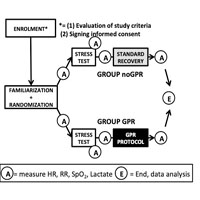 Smart Citations
Smart CitationsSee how this article has been cited at scite.ai
scite shows how a scientific paper has been cited by providing the context of the citation, a classification describing whether it supports, mentions, or contrasts the cited claim, and a label indicating in which section the citation was made.
Effects of a vibrational proprioceptive stimulation on recovery phase after maximal incremental cycle test

HTML: 6
All claims expressed in this article are solely those of the authors and do not necessarily represent those of their affiliated organizations, or those of the publisher, the editors and the reviewers. Any product that may be evaluated in this article or claim that may be made by its manufacturer is not guaranteed or endorsed by the publisher.
Global Proprioceptive Resonance (GPR) is a recently developed approach conceived to solicit the various cutaneous mechanoreceptors, through application of mechanical multifocal vibration at low amplitude and at definite body sites, limiting the stimulation of the profound structures. This interventional study evaluated the effects of GPR on cardiorespiratory function during the post-exertional recovery period. A group of volunteers involved in Triathlon (a multisport discipline consisting of sequential swim, cycle, and run disciplines higly demanding in terms of metabolic engagment), underwent two maximal incremental exercise tests until exhaustion followed alternatively to (a) a 13 minutes section of GPR or (b) a standard low intensity exercise acute trend of the same duration. These effects of these two approaches were compared in terms of recovery of: heart rate (HR), respiratory rate (RR), peripheral oxygen saturation (SpO2) and venous lactate concentration (Lac). The physiological parameters (HR, RR, SpO2 and Lac) recorded in the pre-exertion session showed similar values between the 40 volunteers while several differences were recorded in the post-exertion phase. After 6 min of GPR recovery it was recorded a drop in RR below baseline (19.4±4.15 min-1 vs. 12.2± 0.4 min-1; p<0.001) coupled with an increase in peripheral oxygen saturation above the baseline (GPR: 99.0%±0.16% vs. 96.6%±0.77%, p<0.001). Moreover, the most striking result was the drop in lactate concentration measured after 13 min of GPR recovery: 84.5±3.5% in GPR vs 2.9±7.6% reduction in standard recovery (p<0.001). Notably no differences were recorded recovery of heart rate. GPR has promising effects on post-exercise recovery on RR, SpO2 and lactate level on young athletes.
How to Cite
PAGEPress has chosen to apply the Creative Commons Attribution NonCommercial 4.0 International License (CC BY-NC 4.0) to all manuscripts to be published.

 https://doi.org/10.4081/ejtm.2020.9477
https://doi.org/10.4081/ejtm.2020.9477




